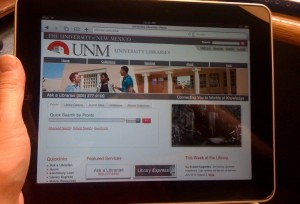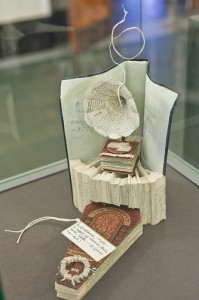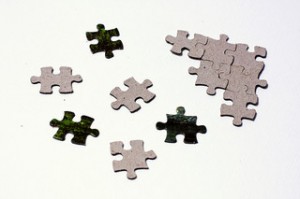Market Efficiency, or, Arguing with Rick
Posted: September 13, 2013 | Author: Steven Harris | Filed under: Collection Philosophy, Online collections | 1 Comment »Let’s have a little argument with Rick Anderson. His recent article from Ithaka S+R makes a lot of good points. The primary thesis is that libraries should concentrate on building up their special collections (non-commodity collections, he calls them) because that is what makes each library unique and building these collections will also result in the preservation of the widest possible selection of our intellectual record. I don’t argue with that. No sense in libraries all developing the same collection of commercially published products.
The backstory of Anderson’s thesis, however, (the backstory of all Rick’s articles) is that we live in an information-rich environment (check) and that (commodity) library collections are of declining value because so much of the information they might contain is more cheaply and readily available elsewhere. BONK!
Anderson says:
Today’s more efficient online marketplace features much lower prices and much lower barriers to personal collection-building, a pervasive full-text searching capability that makes traditional cataloging less obviously necessary, and widely distributed storage and access points that undermine traditional approaches to preservation and curation. (p. 3)
Some elements of that are partly true. There is a tremendous growth in full-text searching capabilities (“pervasive,†I don’t know), the Internet generally offers many storage and access possibilities that did not exist before, and the cost of some things is lowered by the 1000-pound-gorilla-ness of Amazon e-book pricing. But here’s my point: only a fraction of the scholarly communication record is affected by these factors.
Anderson suggests (p. 2) that because it is more possible (technologically) for scholars to share articles with one another, the need for such materials to be held and distributed by libraries is diminished. Clearly, it is faster and easier for scholars to share articles with one another today than it was 40 years ago, but there is no evidence I have seen in the literature that says this amounts to a majority of uses of scholarly articles or that this kind of sharing is responsible for a decline in library access. In fact, presumably scholars could by-pass use of the library copy in only three situations: for articles they wrote themselves (easily shared with others), for articles from journals for which they hold a personal subscription (easily accomplished but of dubious copyright and ethical status), or for articles that are freely available in an open repository (the sense of sharing in that case is not quite an accurate representation). It is implausible, in the first instance, that EVERY use of a scholarly article would be mediated by the author of the article. If that were true, the need for scholarly journals would cease to exist altogether. In truth, a great deal of sharing within the scholar community is accomplished, I would suggest, from downloading PDF files from library holdings. Obviously, the open access movement plays a significant role in the enhanced sharing of publications outside the commodity environment, but does anyone believe this is now the primary way scholars share information? The continued promotion/tenure scramble to be published in “top-tier†journals suggests otherwise.
The idea of lower cost and lower barriers to personal collection-building being the drivers of diminished library use (or at least relevance) certainly warrants study, but I don’t think it has been demonstrated and I doubt it would hold up under careful analysis. Do scholars today personally buy a greater percentage of the resources they use compared with scholars of the past? Perhaps marginally. Are scholars acting as intelligent consumers in the scholarly communication marketplace, finding the lowest price in all instances? Doubtful. At any rate, if they were behaving in that way, a free library copy would always be the best option. Interlibrary loan anyone?
The cost of almost all scholarly publications have, in fact, continued to go up relentlessly. Journal subscription prices outstrip the CPI every year. Even purchase-by-the-article services tend to run in the $25 to $50 range per article. Scholarly monographs are rarely cheaper than $50 per title. The existence of efficient distribution channels and digital options have not changed that very much. As an example, here are a couple of items my acquisitions team has dealt with recently:
- Evolution and Human Sexual Behavior. Harvard University Press, 2013. We paid $33.24 through our regular academic book vendor. The hardcover edition is listed on Amazon at $35.67. There are 11 used copies listed there as well. None is cheaper than $34.50. There is a Kindle edition available at $31.16. No great savings in any case. What may make the Kindle version appealing is the instantaneous access rather than the price, but Kindle would not serve every user need.
- Guidelines for Chemical Process Quantitative Risk Analysis. American Institute of Chemical Engineers, 2000. Again our vendor is selling it for $254. Amazon lists it at $190. Used copies are more expensive than that. It doesn’t exist in the commercial, individual-user e-book market. Knovel offers it through a subject package and several other library platforms have it at $254 or more. This is content that some of our users really want, but they are unwilling to pay $200 for it themselves.
- Plessy v. Ferguson (Landmarks of the American Mosaic). Greenwood Publishing, 2012. $58 from our vendor, $37 from Amazon, $35 for a Kindle edition, $32 for a used copy. Some savings over our commodity-priced version, but not much. This is the kind of semi-academic title that might serve student needs very well, but they wouldn’t want to pay $30 for the right to quote a few lines. (Although that IS a use some students might find for the Google Books edition, provided that the appropriate snippet could be found in the limited-preview.) Faculty might be interested in using the book as a teaching text, but it probably wouldn’t serve their research interests. Few would pay for it themselves. Thus, the savings through Amazon is still not that appealing.
Let’s face it, the nature of library collections and collection use is changing due to an expanded digital infrastructure, but scholars and students continue to rely for the most part on the same kinds of resources: scholarly journal articles, scholarly monographs, and reference resources. The fact that these are available digitally and in a piecemeal fashion does not change their overall cost or make them more collectible by individuals. Their pricing, I suspect, still puts them beyond the reach of most users. But I’d be willing to be proven wrong. The mere existence of Amazon and e-book readers or Google and its Books and Scholar platforms does not necessarily demonstrate that these are the causes of declining library use or expanded information-consuming power for users. I’m not sure correlation is evident, let along causation. I think we need a lot more ethnographic studies of user behavior and its subsequent impact on scholarly publishing before we can make those kinds of assertions. But I’m totally on board with asserting that we should expend more effort and money on developing locally relevant special collections. Go for it.
Want and Need
Posted: April 29, 2013 | Author: Steven Harris | Filed under: Collection Philosophy | Tags: instruction, Patron-driven | Leave a comment »Someone should write this history of librarianship: the longstanding tension between “give them what they want” and “teach them what to want.” Both have been with us almost from the very moment of birth of professional librarianship. Both have elements of nobility. Both have elements of condescension.
“Give them what they want” grants agency and, hey, even intelligence to library users. “Teach them what to want” is aspirational. We all can learn something new and keep on learning throughout our lives. Let’s look away for now from the nasty verso that each bears about the worthiness of library users–that what they want is of dubious quality–one says, “so what,” the other says, “this must be remedied.”
“Teach them what to want” had the upper hand in this fight for a long while, but “give them what they want” has made some serious inroads lately. Ah, but maybe it’s all a false dichotomy. Maybe we really can do both, even though it seems like they are diametrically opposed. Maybe we can add anything to the collection that someone wants but continue to teach skills about finding something better. No conflict there, eh?
Ithaka Faculty Survey
Posted: April 10, 2013 | Author: Steven Harris | Filed under: Collection Analysis, Collection Philosophy, Library users | Leave a comment »The 2012 Ithaka Faculty Survey of information behaviors hit the street this week. I’m not sure there are any great surprises in the report. The progression towards use of electronic materials continues at about the same pace. The disciplinary differences between humanities, social sciences, and sciences seem about the same as previous years. They are all shifting in their behaviors in the same direction.
What is fairly constant as well, is that most faculty continue to think that the most important activity of the library is to acquire or provide access to scholarly material. “The library pays for resources I need…” is uniformly the highest response in several questions about the role of the library. (See pages 63-76.) Of course, anyone who has looked at Libqual data will know this as well.
Contrast this with responses from library directors, especially regarding the development of library support services for scholars, and you begin to see a disconnect between scholar desires (or knowledge of library services, at least). On some issues there is almost a 40% difference in response rate between faculty and library directors. “The library supports and facilitates my teaching activities,” for example, or, “The library provides active support that helps to increase the productivity of my research and scholarship,” are both questions to show a wide gap between faculty and library directors.
Library collections continue to be very important for scholars. We need to continue thinking about the best ways to serve those scholarly information needs.
Dysfunctional and Codependent
Posted: August 14, 2012 | Author: Steven Harris | Filed under: Collection Philosophy, humor | 3 Comments »There is a dysfunctional and codependent relationship going on in libraryland. (No! Not ebooks!) I’m looking at you, print books! We’ve shacked up with print books for so long, everybody thinks it’s a common law marriage. And still we won’t admit that this is a “books who hate librarians and the librarians who love them” relationship. Denial.
Let’s look at this crazy relationship:
First of all, our lover turns out to be a hoarder. A&E show got nothing on this loony. Did you ever think maybe there are enough books? How about throwing something way? It’s bad enough that the collection grows like a cancer with what you’ve forced us to buy, but then you get your lunatic relatives to call us up as well: “I’ve got a garage full of textbooks on accounting from the 1950s and 60s. I’d like the library to have them.” Uh uh, Jack. Then, the whole family is trying to lay a guilt trip on anybody who suggests that something has to go. OMG! What about the cultural record!
Secondly, what we do have won’t stand up to a good reading. Oh, sure, try to preserve this stuff that starts falling apart after 3 uses. I think HarperCollins was being generous with 26! No chance replacing it because the stupid thing has gone out of print. OUT OF PRINT! What the hell is that? You end up borrowing another copy and tipping in a bunch of tacky looking photocopied pages. Hey book! Why don’t you just send all your pages in a box?
Then there’s the lack of standard format. Try organizing a library with all the wildly different sizes that Mr. Print Book comes in. Sometimes we end up with the “over there in the BIG area for no good reason” collection. Don’t even talk to me about those 6-foot tall book nutcases. Sometimes we just say, “screw it!” and cram stuff on the shelf any which way…fore edge down–ripping the cover right off at the spine. Whatever. Who cares? We have not even addressed the question of language. It’s like everybody has a different word for EVERYTHING! How are we supposed to be able to read all this stuff? Some books are even right to left. Back to front.
Here’s a good one. You’ve spent $700 on book and then he says, 9 months later, “there’s a new edition. Everything in the old edition is out of date.” Here’s the thing though. You checked. There are a total of 11 word changes and 7 punctuation changes. RIIIIGHT. New edition. $900 this time. This has a variation too: something that looks like a new book altogether, different title, different ISBN, different author even…turns out to be EXACTLY like a book you already have. Word for word.
But with all these crazy rantings, don’t even dare bring up separation. He starts screaming and wailing. “No, baby. Please. Don’t leave me! I’ll be better. I promise.” But it’s just the same old story over and over again. Whole bloody family ought to go in for therapy. That’s all I’m saying. Or maybe it’s time to think about saving yourself. Get out of this relationship altogether. He’s never going to change.
[Oh lord! Have I become like THAT library columnist?]
Surplus
Posted: July 13, 2012 | Author: Steven Harris | Filed under: Collection Philosophy | 1 Comment »There is a remarkable artistic meme happening all over the world in recent years which involves using books as the material for constructing works of art. This technique is probably not new at all, but its occurrence has definitely exploded in recent years. So much so, that I’ve started maintaining a Pinterest board that I call “Books that aren’t books.” These works run the gamut from minute and intimate sculptures carved from the pages of books to massive and menacing art installations.
In the later category, Spanish artist Alicia Martin excels. Some of her huge installations involve thousands of books wired to mesh infrastructures inhabiting various urban spaces, some giving the sense of the books spewing (being vomited almost or worse) from buildings.
Others have a smaller but no less menacing aspect, like so many books reproducing uncontrollably behind walls to the point of over-population, putting one in mind of Star Trek tribbles.
On a smaller but more mysterious scale, in the past year in Edinburgh, Scotland, an anonymous artist began to secretly leave tiny, book-scarved sculptures in various libraries of the city. Each was accompanied by a card with words of praise for libraries and readers: “A gift in support of libraries, books, words, ideas…” The identity of the artist was never revealed.
Other notable artists of both the carved book and installation form include:
Even libraries are getting in on the act, creating Christmas trees out of volumes of the National Union Catalog, and reference desks from stacked books. At my own university, an art student constructed an installation right outside our art library of books he got from the public library – skewered on metal cables.
The artworks themselves are beautiful and intriguing, but I am more fascinated by the sociology of the phenomenon. What does it all mean? Why is it happening now? Two things I think it suggests. One is a perceived and an actual surplus of books. None of these works could be created without access to large numbers of otherwise unwanted books. The one case I know of, the books came from a library surplus that was headed for the recycling bin. I’m sure many of the other artists got their materials from libraries or book dealers. Public libraries weed their collections regularly to maintain a current and circulating stock. Many large academic libraries, which have heretofore maintained collections seemingly in perpetuity, have begun to draw down their print collections to rely on shared print repositories or digital surrogates.
A second explanation, I think, is that people feel guilty about that surplus. Why are we throwing away books? Aren’t books a sacred commodity? Faced with that sense of guilt, those with an artistic inclination want to make something else useful out of these objects, if they aren’t going to function as books any longer. Sometimes, it’s as though the art is commenting on that duel relationship of surplus and guilt. Books carved into coffins! Books pinned onto cables. Books ejected through a window! These are interesting times we live in. The time of the Internet. The time of the Kindle, Nook, and iPad. Is there still a place for the physical book? We don’t know. And some of us are a little disturbed by the uncertainty.
A library always has information
Posted: July 11, 2012 | Author: Steven Harris | Filed under: Collection Philosophy | Leave a comment »Information is a dreadful word – stuck somewhere between the cold mathematics of Shannon and Weaver and the commercial commodification of even worse words like “content” and “product.” But how else do we describe the “content” of a library? “Knowledge” and “data” have special sorts of meaning that don’t always apply to what a library provides. Information is what libraries do. Without information, there isn’t a library.
That is going to strike many in the library profession as an old fashioned, even reactionary view. In recent years, we’ve come to think of libraries and librarianship as a suite of services and activities that cannot be reduced to a dictionary definition about a collection of materials or the location in which the collection is housed. We put up quite a hullabaloo when OCLC published Perceptions of Libraries in 2010, which suggested that when people thought about libraries they thought, “books.” ARRRRRRRGH would generally describe the librarian response in the blogosphere. We don’t want to think of ourselves as the sum of all information in a collection. We’re more than that!
I think there are several explanations for the development of this reaction against “the library as collection.” First, of course, is that the library is largely virtual. It doesn’t exist in a place the way it once did. The fact that the information of a library exists less and less in a physical container suggests that the actions required to access and use information are more important now than the physical embodiment of the information. Then, since information is disembodied, as it were, it is everywhere. People don’t have to come to libraries to get information. It is floating in the air. They can find it on their phone. Our declining circulation numbers attest to this and at the same time give us a sense of doom about continuing to pin our star to “the library as information.”
Of course, libraries have always been a combination of things and actions. We acquire books. We organize and describe materials. We help people find information. We teach people to navigate a sea of data. Sometimes a single person provides all those services. Sometimes there is a division of labor. Sometimes there is conflict and disagreement between one division and another. Each group thinks of itself as the “heart” of the library enterprise.
There seems to be a growing belief that the actions of libraries are more important than the things. A library isn’t information–it is the ability to find information. It is a place that will teach you how to find information. It is a service that enables the provision of information. Maybe it is even a place where people gather to create information. Yes, all of those are true. I embrace all of those visions of a library. But here’s the thing: information is the object of all those actions. They are sentences that are incomplete without “information.” Even in a world where we don’t own or physically hold the information, where all of our actions are directed away from a local collection, information is still the reason we exist. If a library isn’t information or the means to access information, then all of our actions could as easily be ascribed to or performed by schools, businesses, consultants, or other entities. We don’t need libraries in that case.
Because libraries are a constellation of actions that point towards information, we need to continue thinking of information as central to our mission. Otherwise, we are doing something other than librarianship.
Ebooks in K12
Posted: June 5, 2012 | Author: Steven Harris | Filed under: Collection Philosophy, E-books, Professional development | Leave a comment »Here is an interesting workshop for those in K-12 being offered by ALA Techsource:
“Choosing an E-Book Platform that Works for Your K12 Library”
being lead by Buffy J. Hamilton
August 8
http://www.alastore.ala.org/detail.aspx?ID=3832&zbrandid=4634
Collaborative Collection Conference
Posted: May 25, 2012 | Author: Steven Harris | Filed under: Collection Philosophy, Professional development | Leave a comment »Collaborative collection development has been on our lips for 30 years. It’s one of those topics that, to paraphrase Mark Twain (or whoever), everybody talks about but nobody does anything. I exaggerate. There have been a lot of what I’ll call prospective collection collaboration: shared subscriptions, buying clubs, cooperative approval plans. But retrospective collaboration is a tough nut. “Retrospective collaboration?” you say. What to do about managing existing collections, especially monograph collections, in a collaborative fashion? How to weed our monograph collections in an extensive fashion (creating spaces for other activities), while still preserving the greatest diversity of the scholarly and cultural record? Now THAT is on my lips all the time these days.
And its on the lips of several great presenters for ALCTS. See this ALCTS virtual preconference to learn a lot more about this kind of collaboration:
Local Collections, Collective Context: Managing Print Collections in the Age of Collaboration
June 4-6: there are three sessions, 90 minutes each, beginning at: 11am Pacific, noon Mountain, 1pm Central, 2pm Eastern
http://www.ala.org/alcts/events/ala/ac/12/collaborationage
Sign up now! I’ll see you there.
Why?
Posted: May 18, 2012 | Author: Steven Harris | Filed under: Collection Philosophy, Professional development | 2 Comments »I had tea yesterday with a long-time Medieval Studies/English Literature faculty member here. She has always been a heavy user of the library and a real supporter of everything we do. She’s actually retired but still doing a lot of things in the English Department on a part-time basis. Yesterday, she turned to me and asked earnestly, “why is the library going so electronic in everything it does?”

How would you answer that question?
Legal Beagles
Posted: March 2, 2012 | Author: Steven Harris | Filed under: Collection Philosophy | Leave a comment »All I’m thinking about today are legal issues. Is this what library collection development has come to? And are they teaching students about this in library school? There are, of course, the usual license agreements for subscriptions and electronic resources, but I have some other more specific issues on my mind:
- Hathi Trust: we’ve been thinking about joining this collaborative organization. I think they are doing important work to ensure the preservation of digital collections. They started with a base of materials digitized by Google from libraries in the Big 10 (and some others), but Hathi is managing these digitized materials with more of the librarian’s concern about preservation, more than Google, certainly. But now there is the sword of Damocles, in the form of a lawsuit from the Authors Guild, hanging over Hathi’s head. I don’t really know all of the ramifications of the suit, or how much it might affect the benefits of joining the organization. But it gives one pause.
- WEST: this is another collaborative organization that my library HAS joined. The organization is working to create a distributed print repository of print journal holdings. The idea is to ensure at least one print copy of selected journal titles exists within the member libraries of the organization. In order to make the print holdings as complete as possible, some libraries will ask others to contribute journal volumes to fill out a complete run. Here is where the legal issues come in. My state has specific laws about disposing of state property (including library collections of state universities). Can I convince our legal counsel that sharing some volumes from our journal holdings with another library in another state is legal and in our best interest? If we can’t contribute toward the collective holdings of the organization, are we even valuable members?
- Costco v. Omega: who would have thought that a lawsuit between a mega-store buying club and a Swiss watchmaker would have any impact on an Academic library? This issue came up because someone donated a 6-volume British publication to my library. I mentioned it online and someone suggested that Costco v. Omega may come in to play, especially for a donated book. You see, the Supreme Court ruling (or none-ruling) in this case upholds a lower court ruling (at least in the Ninth Circuit Court) that libraries do not have the protection of the right of first sale regarding materials not manufactured in the United States. What that means is that libraries may not even have the right to circulate foreign publications. Sheesh! Some legal beagles are saying not to worry. There are other protections the cover library activities (beagle1.pdf and beagle2.html). Some of the protections suggest that if you bought the material in a legitimate way, there is a presumption that permission to do library stuff with it is understood. That also presumes, however, that you can demonstrate how you purchased the material. Because of the vagaries of our ILS, we do not even maintain purchase orders for books in our system for more than 2 years. We still have copies of the invoices. But how would we match a particular book purchased 5 years ago with its corresponding invoice? We also do not have title-by-title records for most donations. Extra Sheesh! I wonder what libraries in the Ninth Circuit are doing.
Thus, I spend the day worrying about the law and not thinking about how to build a good library collection. Maybe I should go to law school.






